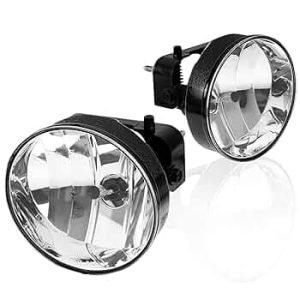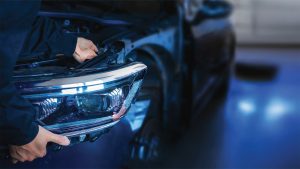Proper vehicle lighting is essential not only for visibility but also for safety. Among the many lighting components on a car, fog lights and driving lights are often confused — both by new drivers and even experienced vehicle owners. Though they might seem similar, these lights serve very different functions and are designed for specific conditions. Understanding the difference can help you drive safer and comply with traffic laws.
In this article, we’ll break down how fog lights and driving lights differ, when to use them, and how to choose the right setup for your car.
What Are Fog Lights?

Fog lights are low-mounted auxiliary lights designed to improve visibility in fog, mist, snow, or dust. Their unique beam pattern is wide and flat, angled downward to illuminate the road surface directly ahead without reflecting off airborne particles.
Key Characteristics:
-
Beam Pattern: Wide, short, low
-
Position: Low on the front bumper
-
Use Case: Poor weather visibility (fog, rain, snow)
-
Color: Typically yellow or white
Advantages of Fog Lights:
-
Reduce glare from fog or snow
-
Improve close-range visibility
-
Less distracting to other drivers
What Are Driving Lights?
Driving lights, also called auxiliary high beams, are meant to extend your visibility at high speeds during nighttime or rural driving. They provide a long-range beam that supplements your car’s standard high beams.
Key Characteristics:
-
Beam Pattern: Narrow, long, centered
-
Position: Often mounted near headlights or on the grille
-
Use Case: Open road or off-road driving at night
-
Color: Typically white
Advantages of Driving Lights:
-
Improve long-distance visibility
-
Help detect obstacles far ahead
-
Essential for rural or unlit roads
Comparison Table: Fog Lights vs. Driving Lights
| Feature | Fog Lights | Driving Lights |
|---|---|---|
| Primary Function | Improve visibility in poor weather | Extend vision at night or off-road |
| Beam Pattern | Wide and low | Long and narrow |
| Mounting Location | Low on bumper | High or mid, near headlights |
| Best Use Case | Fog, heavy rain, snow, dust | Dark rural roads, highways, trails |
| Glare Risk | Minimal | High (must aim correctly) |
| Legal Use | Often restricted to poor weather | Varies by country/region |
When to Use Fog Lights
Fog lights should only be used during poor weather conditions, including:
-
Fog
-
Heavy rain
-
Snowfall
-
Dust storms
Using fog lights in clear weather is unnecessary and can even be illegal in some regions because they may dazzle other drivers or violate vehicle code regulations.
Signs You Should Turn Them On:
-
Reduced visibility below 100 meters
-
You can’t see the road edges or lane markings
-
Other vehicles appear as faint shapes or outlines
When to Use Driving Lights
Driving lights are meant for supplementary use with your high beams and are ideal when:
-
You’re driving on unlit roads or motorways
-
Visibility ahead is clear but limited by darkness
-
You’re off-roading or navigating rural terrain
These lights are not for city or daytime use and should always be turned off when there’s oncoming traffic, as they can blind other drivers.
Legal Considerations
Many countries and regions have strict regulations on both fog and driving light usage. For example:
-
In the EU, front fog lights can only be used when visibility is seriously reduced.
-
Driving lights must turn off automatically when low beams are selected.
-
Rear fog lights (not covered in this article) have additional restrictions.
Always check your local laws to ensure you’re using lighting legally and safely.
Installation and Replacement Tips
When choosing or installing fog or driving lights:
-
Match the beam type to the use case.
-
Ensure proper wiring and fusing to avoid electrical issues.
-
Use aiming tools or have a professional ensure proper light alignment.
-
Avoid mixing color temperatures — choose either white or yellow depending on road conditions.
Which Should You Choose?
You don’t need to choose either/or — many vehicles benefit from having both fog and driving lights, depending on driving conditions. Here’s a quick guide:
| Driving Habit | Recommended Lights |
|---|---|
| Urban commuting | Fog lights |
| Highway driving at night | Driving lights |
| Mountain or countryside driving | Fog + Driving lights |
| Winter/snow-prone areas | Fog lights |
| Off-road adventures | Driving lights (LED preferred) |
Enhance Your Lighting System

Whether you’re upgrading factory lights or adding new functionality to your vehicle, choosing high-quality lighting is essential. Look for components that are:
-
Weather-sealed
-
E-marked or DOT-approved
-
LED or HID for better efficiency
-
Compatible with your vehicle’s wiring harness
Ready to upgrade your fog or driving lights? Buy Car Lighting online
Final Thoughts
Fog lights and driving lights serve very different but equally important purposes in vehicle safety and performance. While fog lights improve visibility in hazardous weather by cutting through glare, driving lights enhance your range of vision at night or off-road.
Choosing the right lights — and using them properly — can significantly improve your driving experience and safety. Remember to consider road conditions, vehicle type, and local regulations before switching on those auxiliary beams.
For better lighting and safer driving in all conditions, don’t compromise on quality.
Buy Car Lighting online and equip your vehicle for every road ahead.